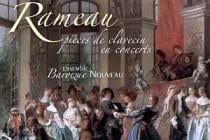At the center of any interpretation of this set is the harpsichordist. Rameau’s Pièces are halfway between chamber music and what most modern music buffs think of when they see words that look like “concerto.” They’re pieces to be played by a wide variety of instruments, which combine in dizzyingly kaleidoscopic ways throughout the set. But the keyboardist gets pride of place in each of the pieces, a point that Rameau makes clear in his preface when he says that they can be played by harpsichord alone, if a gang of friends isn’t available.
Listen to the Music
That’s not to say that the record is without romp. Ornament realizations in L’Agiçante (roughly translated, “the Annoying One”) are irrepressibly cute. The group even had the temerity to do some arranging in the third concert’s “La Timide,” giving an extra phrase to the harpsichord alone — a brilliant idea, given the work’s cyclical, inexorable qualities. Baroque Nouveau’s “live concert” approach allows them to end with two “tambourins” of the third concert. Violinist Anthony Martin contributes great sonorities to these French country dances, lending a decidedly peasanty feel with some fiddle effects that wouldn’t be out of place in a bluegrass band, and bringing the disc to a rollicking close.
The recording isn’t completely without problems. The mastering isn’t quite consistent across the tracks, the whole ensemble sometimes sounding much more present on certain tracks than on others. But the balance between the instruments is just right throughout, which is no small feat. There is a tendency for both of the string players to be out of tune on high notes (including one particularly gruesome connection point in La Coulicam, which probably should have been spliced out). But these are very small qualms to levy against an expertly produced and beautifully played record.
These concerts are actually rather frequently recorded, despite their somewhat obscure generic status. Baroque Nouveau’s rendition is well worth owning. They strike just the right balance between forerunners like the 1971 recording with Gustav Leonhardt, Franz Brüggen, and the Kuijken brothers (which was note-perfect but unforgivably stodgy) and the very different recording from the 1980s by Trio Sonnerie (which features a sexy expressiveness that occasionally shades into eccentricity). I recommend without reservation that this “Reference Recording” become a part of every listener’s library.

